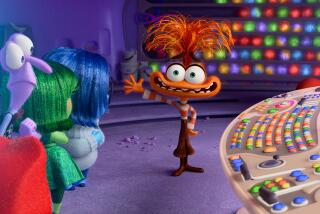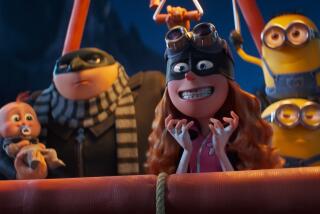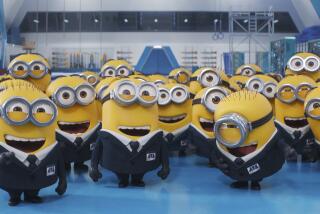‘Grinch,’ ‘Ralph’ and ‘Spider-Man’ lead an animated charge on the holiday box office
In this season’s animated feature smackdown, the studios are betting big on name brands to draw family crowds.
Toon juggernaut Illumination Entertainment (of the “Despicable Me” and “Minions” universe) gets a jump start on the holiday cheer and drops its second Seuss feature, “Dr. Seuss’ the Grinch,” down the chimney on Nov. 9. Just in time for Thanksgiving, Disney uploads its follow-up to a blockbuster Oscar nominee with “Ralph Breaks the Internet” on Nov. 21. Then, Sony takes a massive gamble with its multibillion-dollar superhero franchise with the reality-shifting, visually innovative “Spider-Man: Into the Spider-Verse” as an early Christmas present for comics fans on Dec. 14.
But while all three properties enjoy built-in audience awareness, the filmmakers behind each project had to find what would make them unique within the broader animation landscape.
“Grinch” is, of course, the third page-to-screen adaptation of Seuss’ beloved children’s book “How the Grinch Stole Christmas!” (1957). It enlists the vocal talents of Benedict Cumberbatch and Rashida Jones to — if not make us forget the revered 1966 TV special with Boris Karloff as the green meanie or the 2000 Ron Howard-Jim Carrey live action hit — perhaps take us on a slightly different sleigh ride.
FULL COVERAGE: 2018 Holiday Movie Preview »
Co-directors Yarrow Cheney and Scott Mosier both say they grew up loving the TV version (or, as directors call it, the “Chuck Jones version”). However, to make the project their own, they decided to discard previous adaptations and get their version’s DNA straight from the book. Mosier says one of the most important changes they made was to allow for some understanding of the grouchy protagonist’s motives.
“In the book, there’s this famous thing of ‘No one quite knows the reason,’” says Mosier. “We didn’t want to do this whole narrative about his backstory, but we did want to use visuals to sort of push into the backstory to get some sort of sense of why he is the way he is, why he has these feelings about Christmas.”
Cheney says the most fun was “trying to figure out the heist.”
“It was really fun to design this town that was big enough that it would take a crazy person to steal Christmas from this place,” he added. “So we had to figure out how he does it. Our answer to that was his ingenuity, all the preparations and things he built and outfitted himself with. That opened it up to all these opportunities for invention.”
Opening another tab on the “Wreck-It Ralph” franchise is “Ralph Breaks the Internet,” in which the lovable lunk (voiced by John C. Reilly) and his best friend, Vanellope (Sarah Silverman) ride a wi-fi connection to a whole new world (wide web) to save Vanellope’s game. They get help from a super-savvy algorithm (Taraji P. Henson) and a tough racer (Gal Gadot) while encountering some of the information superhighway’s bumpy roads, including cyber-bullying.
Co-directors Rich Moore and Phil Johnston say they were fascinated to discover in their research the physical nature the actual internet has. It’s not something floating in the clouds; it’s cables and circuits and servers, which inspired the physical worlds that Ralph and Vanellope explore.

Wreck-It Ralph (John C. Reilly) and Princess Vanellope (Sarah Silverman) are back to save a game while travelling through the World Wide Web in “Ralph Breaks the Internet.”
And there’s more. As has been widely discussed by now, many of Disney’s most famous female characters pop up for a while — voiced by most of the original actresses.
“You don’t get much bigger icons than the Disney princesses,” Moore says.
He was surprised how “each one of [the actresses] has so much of themselves in the characters.”
Why Princess Tiana’s look was modified — again — in the ‘Wreck-It Ralph’ sequel »
“I kind of knew that on a low level,” he added, “but to actually see them become those characters, how much they protect them and love them …”
Johnston notes, “They would add things like, ‘She never speaks with contractions.’ We didn’t have inside knowledge of those characters; we didn’t create them. So the women who did were very much quality control.”
Sony had several billion reasons not to abandon its Spider-Man movies, despite the massive success the Marvel Cinematic Universe has had incorporating the classic version of the hero (whose secret identity is Peter Parker and who lives in the same world as Captain America and Iron Man). Fans have just as many reasons to be skeptical that the studio could pull off yet another pseudo-reboot.
Does the world really need yet another Spidey origin story? What comics fan wants to see Spidey stories that conflict with the MCU continuity? And an animated version?
The makers of the nervy “Spider-Verse” — directors Bob Persichetti, Peter Ramsey, and Rodney Rothman, working from a screenplay by Rothman and Phil Lord — respond with a mind-bending trip. It not only establishes a Marvel multiverse as in the comics, allowing Venom and Miles Morales and the Avengers to exist without ever meeting but it also has a heck of a lot of fun while doing it.
Virtually every film coming out this holiday season »
The film is packed with bells and whistles — the groundbreaking look mixes what audiences have come to expect of computer animation with a slowed frame rate of hand-drawn animation. Backgrounds are often slightly color shifted, rather than blurred, to simulate printing errors common to comic books while creating a sense of depth as in stereoscopic cinema.
Bold choices have been made with character design, making minor figures such as the Prowler into surefire fan favorites. But at the film’s center is its lead: The first black/Latino Spider-Man, 13-year-old Miles Morales.
“There was one, like, kind of classic kids’ adventure movie shot that I’ve seen a million times, but seeing it with Miles in it — you know, a kid like that in a movie like this, it brought me back to being a kid,” says Ramsey, who is black. “‘Man, if I could have seen something like that on the screen 30 years ago, 40 years ago, what would it have meant to me?
“It’s a small thing, but it’s a huge thing.”
More to Read
Only good movies
Get the Indie Focus newsletter, Mark Olsen's weekly guide to the world of cinema.
You may occasionally receive promotional content from the Los Angeles Times.







